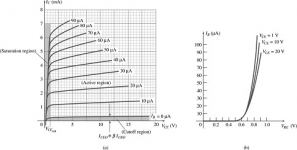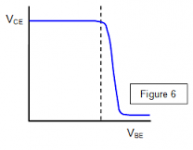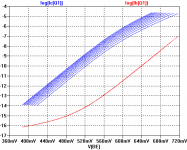Yes, it is easy to build charades, publish incomplete information (scales, step sizes and types, etc...), then let other guess what you mean or intend to show. Must have some entertainment value.
I didnt intend to make you reply as you did..... but was looking at characteristics of devices and some are better than others in their 'raw' state. As to illustrate what i was looking for in a device. And, be ultra low noise.
Do you have any recommendations?
THx-RNMarsh
Last edited:
Spill the beans then, which one is that??
It seems quite good
2SK369
I'll set up the curve tracer to show Vce vs Ib
-RNMarsh
That's the opposite of what I was saying, although I'm happy you volunteered. What I want to see is a Vce vs. Vbe graph, for constant Ic.
I didnt intend to make you reply as you did..... but was looking at characteristics of devices and some are better than others in their 'raw' state. As to illustrate what i was looking for in a device. And, be ultra low noise.
Do you have any recommendations?
Based on your understanding, no. "Device linearity" is an ill (or not at all) defined concept. You may talk about "better quasi-saturation characteristics", better "Early voltage", "lowest nonlinear Cbc or Cgd", etc... Each of these may affect a circuit topology linearity, but a "one size fits all" linearity metric doesn't exist.
Ic = Is * exp(qVbe/KT)
so it would be difficult to ask Vbe to change at constant Ic 🙂
Then why does my Kmultiplier not have infinite PSRR at 1KHz? Vbe DOES change with Vce, given constant Ic. Even the simulator shows this.
Do you (or anyone) have a recommendation?
No, frankly I don't see the point of this exercise especially with artificial constraints. With bipolar noise has nothing to do with "non-linearity" in fact the lowest noise devices are best for log conformance. For JFET's the lowest noise comes with short channel and Vds modulation issues.
This issue of linearity devoid of any application considerations is not an engineering exercise.
No, frankly I don't see the point of this exercise especially with artificial constraints. With bipolar noise has nothing to do with "non-linearity" in fact the lowest noise devices are best for log conformance. For JFET's the lowest noise comes with short channel and Vds modulation issues.
This issue of linearity devoid of any application considerations is not an engineering exercise.
I understand. I wasnt being specific or narrow on purpose. Looking for the best compromise device for audio - line levels. Not MC or microphones or strain gauges et al. Its like asking for the best all around opamp for audio line levels. I might say 5532/4 is best at most things.... it does a lot of things very well. Is there a single device like that for audio IPS?
All devices do better if cascoded and IMO a fet with bipolar for cascode works best ...... Are there very low noise devices with a built-in cascode device in same/one package?
I will try the IF3602 with bipolar cascode and see how it does over-all.
THx-RNMarsh
Last edited:
Any way you could also test a jfet-jfet cascode (Maybe a 2SK369 under a J111?) and show comparative results?
mlloyd1
mlloyd1
... All devices do better if cascoded and IMO a fet with bipolar for cascode works best ...... I will try the IF3602 with bipolar cascode and see how it does over-all.
THx-RNMarsh
Previously, glaring at the Early effect equation did not leave me any the wiser about the relationship between Vce and Vbe. Things are making more sense now however, so I pulled the Early effect equation inside out in order to plot theoretical Vbe vs Vce at constant Ic. I used parameters from my BC337-40 model.
X axis is Vce. This chart shows that at 1Vce, Vbe changes by about 246uV per volt Vce. This corresponds to a PSRR of about 72db which lines up with my experience.
X axis is Vce. This chart shows that at 1Vce, Vbe changes by about 246uV per volt Vce. This corresponds to a PSRR of about 72db which lines up with my experience.
Attachments
Are there very low noise devices with a built-in cascode device in same/one package?
IF has something like that. It's under amplifiers, not FETs.
Contains a lot of FETs in a metal can package.
Had to smile yesterday when I saw it because just b4 I had written that
the the IF3602 needs a Miller killer.
To exotic for me to be useful, so I didn't watch it closely,
but probably it has the right HiEnd appeal.
OTOH, several transistors in one can make it an integrated amplifier.
Can't look it up now, it is late evening here and I still have to drive 270 Km home.
Gerhard
Last edited:
used to be, but discontinued (surprise, surprise) a long time ago. i might even remember the part number after having some pepsi ...
As I think about it, Nelson might; I think he used in a product a while back ...
mlloyd1
As I think about it, Nelson might; I think he used in a product a while back ...
mlloyd1
... Are there very low noise devices with a built-in cascode device in same/one package?...
THx-RNMarsh
The IF 3600 series really needs a cascode bipolar is my preference also. They are very low noise but I think the Toshiba solution is still better although you can't get them easily. The 3601 are just a big chunk o Silicon to work with.
Are there very low noise devices with a built-in cascode device in same/one package?
Yes. And low noise as well. Of Sanyo extraction.
Where is the input fet, Waly?
Huh? Between pins 2, 3 and 4?
An interesting take on a common source of flicker noise...
http://rubiola.org/pdf-articles/conference/2004-fcs-dc-amplifier.pdf section III, "page 472"
Hmmmm, could be why there are such different numbers for BF862 noise measurements.
http://rubiola.org/pdf-articles/conference/2004-fcs-dc-amplifier.pdf section III, "page 472"
Hmmmm, could be why there are such different numbers for BF862 noise measurements.
- Status
- Not open for further replies.
- Home
- Member Areas
- The Lounge
- John Curl's Blowtorch preamplifier part II



